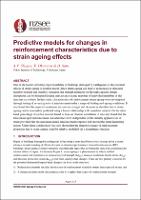| dc.contributor.author | Shegay, Alex | |
| dc.contributor.author | Okamura, Koushin | |
| dc.contributor.author | Sato, Daiki | |
| dc.date.accessioned | 2023-08-28T04:23:25Z | |
| dc.date.available | 2023-08-28T04:23:25Z | |
| dc.date.issued | 2023-04-19 | |
| dc.identifier.uri | https://repo.nzsee.org.nz/xmlui/handle/nzsee/2574 | |
| dc.description.abstract | One of the factors affecting repair feasibility of buildings damaged by earthquakes is the potential effects of strain ageing of reinforcement. Since strain ageing can lead to an increase in structural member strength and ductility reduction, the strength hierarchy set through capacity design disruptions can be disrupted leading unexpected seismic response of individual members or the structure as a whole. In this study, characteristics of reinforcement strain ageing were investigated through testing of several grades of reinforcement under a range of loading and ageing conditions. It was found that the expected maximum increase in strength and decrease in ductility due to strain ageing can be reasonably predicted using a linear relationship with vanadium content. On the other hand, percentage of carbon was not found to have an obvious correlation. It was also found that the final strain aged reinforcement characteristics were independent of the initially applied level of strain provided that the maximum initial reinforcement response had entered the strain hardening region. Under these conditions it was also shown that the temporal change of reinforcement properties due to strain ageing could be reliably modelled via a logarithmic function. | |
| dc.language.iso | en | |
| dc.publisher | New Zealand Society for Earthquake Engineering | |
| dc.relation.ispartofseries | 2023;110 | |
| dc.subject | Advancements in research and practice in seismic performance | |
| dc.title | Predictive models for changes in reinforcement characteristics due to strain ageing effects | |
| dc.type | Article | |

